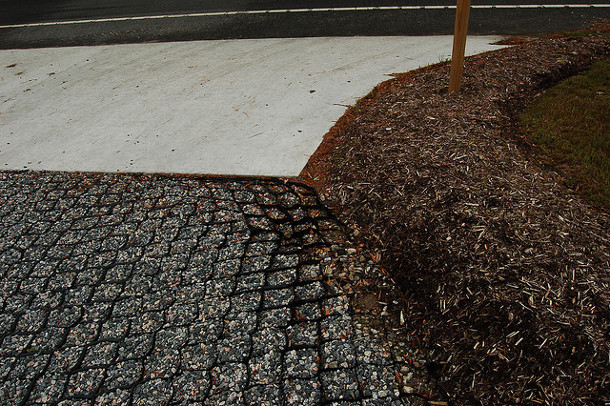Most designers are probably already familiar with the practice of using aggregate or gravel as a form of underground stormwater storage. For those who aren’t designers, the principle is simple: aggregate (gravel) is full of small voids – macropores – that can fill with water, acting as on-site stormwater storage. The aggregate is strong enough to support the weight of paving, as well as pedestrian and vehicle loading, making this solution attractive for dense urban environments.
Aggregate isn’t the only material that’s used for this. There are several types of media that use macropore storage as a means of on-site stormwater management. Three of the primary ones are:
1) High quality loam with low compaction (less than 85 percent)
2) Large-grained clean sand (0.5mm to 2.0mm) with low compaction (less than 85 percent)
3) 0.75” to 1.5” clear angular rock (aggregate) with high compaction (90 percent)
High quality, lightly compacted loam has about 20 percent stormwater storage capacity, large-grained clear sand has about 30 percent stormwater storage capacity, and clear angular rock (aggregate/gravel) has about 40 percent stormwater storage capacity. Note that all of these figures refer to water that is temporarily stored in the media between saturation and field capacity. If we assume 1,000 cubic feet of each type of media, this works out to the high quality loam holding about 200 cubic feet of water, large-grained clear sand holding about 300 cubic feet or water, and clear angular rock holding about 400 cubic feet of water. That makes clear angular rock the best choice for storing stormwater – right?
Not necessarily. When evaluating the effectiveness of these options as “green” stormwater management practices, there are three types of benefits to consider:
Volume runoff reduction (the amount of runoff prevented from leaving the site)
Runoff rate (the speed at which runoff leaves the site)
Quality (pollutant reduction)
Aggregate and sand are both efficient options to address volume and runoff rate because they infiltrate large quantities of water very quickly. Volume control is extremely important; even taking a small amount of water “offline” – that is, out of sewers, especially in areas with combined systems – can help avoid flooding and the spread of non-point source pollution. Runoff rate is also very important. If rain water can’t be absorbed or contained quickly enough, then flooding and pollution will remain problematic. Aggregate and sand do provide some stormwater quality benefits although, depending on the pollutant, not as many as vegetated loam.
Like aggregate and sand, vegetated best management practices – those that use plants and soil – do a great deal to reduce stormwater volume and runoff rate, although they are slightly less efficient (again, soils has approximately 20 percent holding capacity by volume, while aggregate and sand have 40 percent holding capacity and 30 percent holding capacity, respectively). Unlike sand and aggregate, soil and plants provide the additional benefit of significantly improving water quality by removing pollutants like TSS (total suspended solids), metals, nitrogen, phosphorous, pathogens, and hydrocarbons.
Vegetative solutions have another powerful stormwater treatment mechanism that doesn’t factor in to most calculations: the plants that grow in them. Through interception and evapotranspiration, trees can prevent a significant amount of rainfall from ever reaching the ground. And as trees get larger, they can intercept and evapotranspire greater quantities of rainfall and retain dissolved nutrients efficiently, meaning that vegetated stormwater management solutions should, with proper maintenance, actually improve over time.
Gravel and sand are effective at managing stormwater runoff and volume and have their place in certain circumstances. But I do object to them being considered “green” best management practices. They don’t adequately address the third piece of the solution, and one that is essential to true sustainability – water quality. And you certainly can’t grow anything with them. Dense urban areas need effective on-site stormwater management solutions. Wherever possible, we should pick ones that address every aspect of the water cycle.







I didn’t know that aggregate could be used to store stormwater but from what you’ve written it looks like a very effective method. The post outlines the factors involved in stormwater retention well with listing volume runoff reduction, runoff rate, and quality and how aggregate handles these factors. Thanks for the helpful aggregate post.